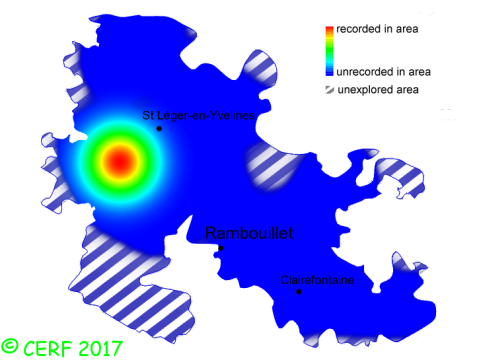|
Conocybe tenera (Schaeff.:Fr.) Fayod
|
common name(s) : Common Conecap
New classification: Basidiomycota/Agaricomycotina/Agaricomycetes/Agaricomycetidae/Agaricales/Bolbitiaceae
Former classification: Basidiomycota/Homobasidiomycetes/Agaricomycetideae/Cortinariales/Bolbitiaceae
edibility : inedible
|
|
|
The cap is ochre to reddish tawny-brown, hygrophanous but barely, becoming more yellowish when drying, conical at first, then bell-shaped; its margin is sulcate-grooved when young or damp, later smooth.
The cap surface is smooth, matt, dry, slightly glistening when dry.
The stem is whitish to more or less concolorous to cap, then becoming dark reddish-brown from the base up with age, cylindrical and hollow, fragile, pruinose especially towards top, without ring.
The flesh is thin, concolorous with cap, unchanging; its taste is faint, mild; the odour is very faint, mushroomy;
its texture is fibrous.
The gills are creamy-white then cinnamon brown, ascending to shortly adnate or adnexed, with a flaky whitish edge, rather close .
The spore print is bright brown yellow to brown ochre. This species is saprophytic.
It grows on the ground, in grassy areas of parks, gardens, edges of paths, on rich soil, on a rather moderately rich soil.
The fruiting period takes place from June to December.
| Dimensions: | width of cap approximately 2.5 cm (between 1 and 5 cm) |
| | height of stem approximately 7 cm (between 3 and 11 cm) |
| | thickness of stem (at largest section) approximately 4 mm (between 0.5 and 7 mm) |
Chemical tests : positive reaction to Ammonia.
Distinctive features : ochre-brown cap, hygrophanous, conical at first then bell-shaped, sulcate up to disk; pruinose stem, becoming reddish-brown with age from the base up; in parks, gardens or forest edges on rich soil
Conocybe tenera is rare and confined in the forest of Rambouillet, and is occasional, more generally speaking
.
|  | | Above : distribution map of Conocybe tenera in the forest of Rambouillet |
|
page updated on 14/01/18